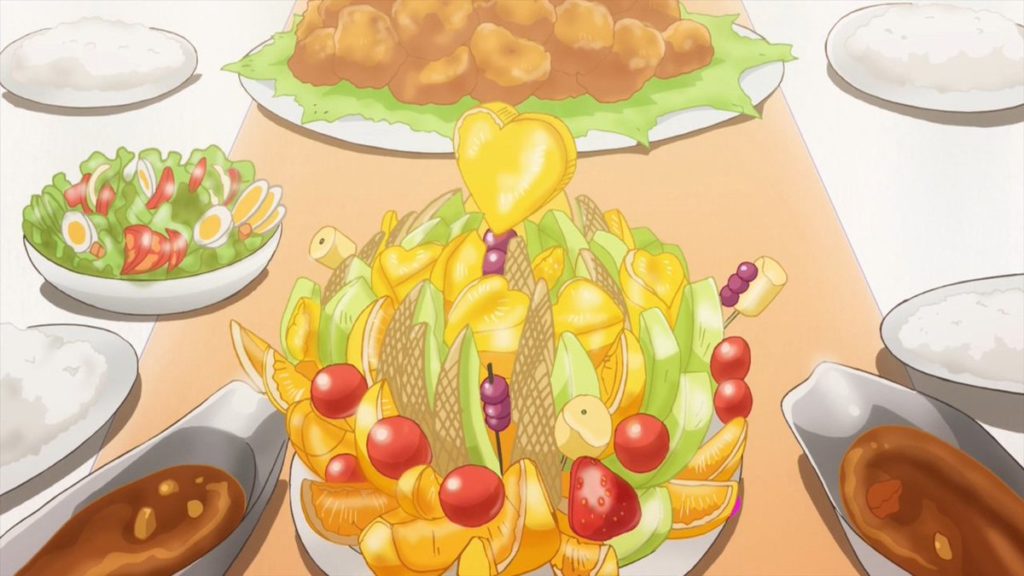When you think about the influences of anime, you probably think of people coloring their hair, elaborate cosplays and amazing action scenes. Of course, there are also not so great influences, such as the infamous body-pillow wives. But anime features a lot more than stirring drama, breathtaking action and villains who would make Homelander cringe in fright. They also often feature delicious meals.
Anime food is surging in popularity as more and more people become interested in watching anime. But is there a deeper meaning when anime feature food, like tuna onigiri and spicy ramen?
Today, learn more about the importance of anime food and why they matter in fiction.
Food-centric Anime

Anime are as varied as any other entertainment medium. They cover slice-of-life comedies, romantic drama, epic adventures and yes, even cooking drama. There are plenty of anime that specifically portray cooks, chefs and other gourmands in action.
One of the most recent food-centric anime is “Food Wars,” about the son of a small restaurant owner who enrolls in a prestigious culinary academy to improve his cooking skills. Will his talent with Japanese food be enough to shine in such a competitive environment? The show is extremely well received and is ranked in the top 20 percent of all anime.
“Food Wars” is by no means the first anime to feature cooking as its main conceit. Chuuka Ichiban, also known as “Cooking Master Boy,” featured a boy in 19th century China trying to become the best chef in all the land. The series first aired in 1997 and featured a lot of over the top anime food.
Even anime that aren’t exclusively about cooking will often lovingly feature Japanese food and other meals beloved in Japan. Hayao Miyazaki’s movies, such as “Spirited Away” and “Howl’s Moving Castle,” have scenes involving food that will make any viewer’s mouth water.
In serialized anime, even slice-of-life comedies will often go out of their way to showcase food. Farcical high school anime like “Ranma ½” and “School Rumble” both have episodes dedicated to staple anime food like spicy ramen and takoyaki.
The animation in these shows often show how delicious food can be, rendering eggs, noodles and meat in breathtaking detail. Just by looking at stills of these shows, you can be forgiven for growing hungry or attempting a chicken katsudon recipe.
Anime Food in the West

The proliferation of anime and associated merchandise outside of Japan has also made anime food increasingly popular. Professional cooks now publish recreations of food from anime, such as tuna onigiri or Japanese chicken curry. YouTube channel “Binging with Babish,” which has over 8.8 million subscribers as of writing, has recipes for food from Food Wars, “JoJo’s Bizarre Adventure” and “Howl’s Moving Castle.”
There are also actual cookbooks dedicated to helping readers recreate anime food. These cookbooks often contain instructions on how to recreate iconic bento boxes, make flavorful spicy ramen from scratch and provide recipes for chicken katsudon. Aside from professional cooks and published cookbooks, there are also countless of amateur chefs who have attempted to recreate their favorite anime food.
There are even establishments that make it their whole schtick to serve anime food or remake dining experiences normally only found in anime or in Japan. These include maid cafes and cosplay restaurants, famous for their costumed employees and exquisite Japanese food.
But why is it important that anime showcase food? Aside from aesthetics, is there a significance to how they’re portrayed or if they’re portrayed at all?
The Importance of Food in Fiction

Novelist Jamie Harrison wrote a profound think-piece for Lit Hub about the important of food in fiction, but she was writing specifically about their appearance in books. There are a few important differences when food is presented in an audiovisual medium such as anime. The inclusion of food in any media has a purpose, at least if the creator is good at what they’re doing.
Anime food carries significance for a host of factors, but namely for the following reasons.
-
Provides Immersion
When you watch a live-action movie, you are already distanced from the events of the movie because you can only see and hear them. When people watch anime, the realism and immersion is even harder to achieve because of the stylized nature of the animation. Anime food helps establish that the characters in anime are living beings who need sustenance.
Eating is a universal concern and watching anime characters fawn over food and do day-to-day activities such as shop for ingredients and cook family meals helps you connect with them. The great detail most anime animators devote to illustrating and bringing the food to life also helps with immersion.
-
Establishes Character
The adage “you are what you eat” helps explain why food is so important in developing characters. In western canon, we hate Hannibal Lecter because he’s a disturbing cannibal, but we love him because of his mouthwatering meals and showmanship in the kitchen. In anime, a character’s relationship with food can work just as well as interacting with other characters.
In xxxHolic, interdimensional and immortal witch Yuko is a fearsome and terrifying character, but she enjoys food and beverage just as much as the other main characters. This shows that despite her strange nature and unsettling features, Yuko is still a benign force. The opposite can also be true. A character who doesn’t eat can seem scarier and inhuman for eschewing such a basic need.
-
Provokes Thought
Food can be avenues to deeper thought and subtle symbolism. In live-action media, this is perhaps most showcased in 2019’s “Parasite.” In the movie, affluent Mrs. Kim asks her deceptive and impoverished housekeeper to prepare “ram-don,” a mixture of spicy ramen and udon noodles. This is actually a normal combination in South Korea. But she then has them add extremely expensive Hanu beef as a topping. This highlights just how much the Kim family takes things for granted.
In anime, Tomie, the terrifying protagonist of her titular manga and anime, demands that she be fed foie gras and caviar. Tomie is the personification of obsession, shallowness and lust. Her desire for food that seems to be the epitome of class highlights her pettiness. It also subtly implies that Tomie, ostensibly a Japanese woman, has nothing but disdain for Japan and puts high stock in foreign products.
-
Displays Heritage
Anime is mostly unabashed in their pride of their home country. Anime food often highlights their heritage, showcasing the deliciousness of Japanese cuisine. Anime will also frequently showcase their many festivals, with delicious morsels on display. Who hasn’t watched a slice-of-life anime and seen characters stop at a cart for some spicy ramen? Many people also discovered that Japanese chicken curry was popular in the country thanks to anime like School Rumble. Other culinary treasures that gained massive popularity in the west thanks to anime include all forms of rice balls. Tuna onigiri, pickled plum onigiri and seafood onigiri are now all well-known in certain circles thanks to anime.
Even characters within anime can be very proud of their Japanese heritage through their food. In Food Wars, the protagonist is the son of a small restaurant owner. Even though he enrolls in an upscale culinary school, he never forgets about his roots and continues to cook Japanese food with pride.
Food is elevated in fiction, especially anime food. Their inclusion in any narrative is supposed to highlight characterization, showcase heritage and deepen immersion. The next time you watch anime, you’ll know that the food won’t just feed your eyes but also nourish your viewing experience.





